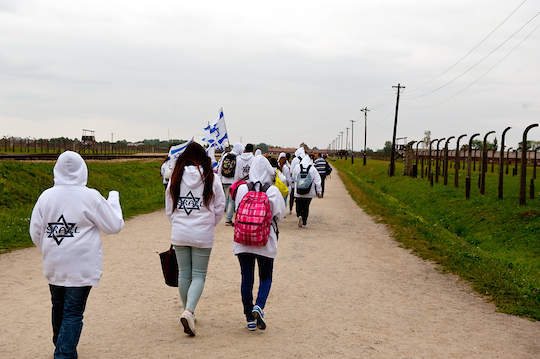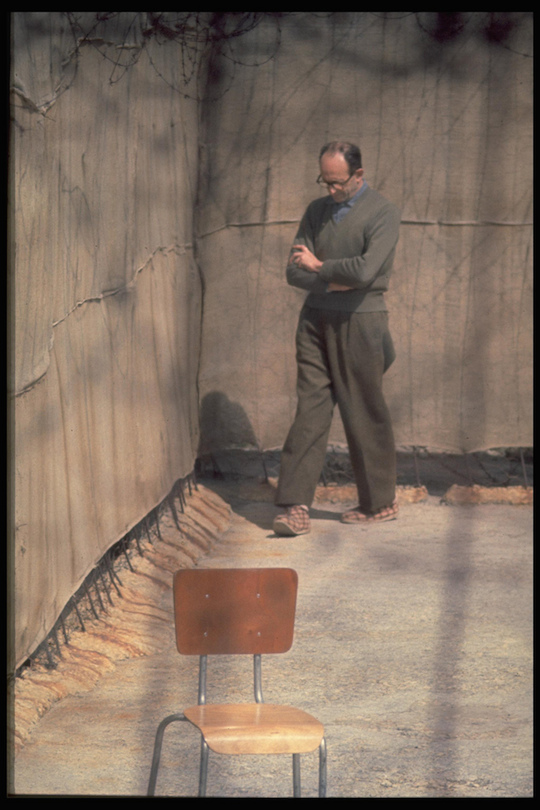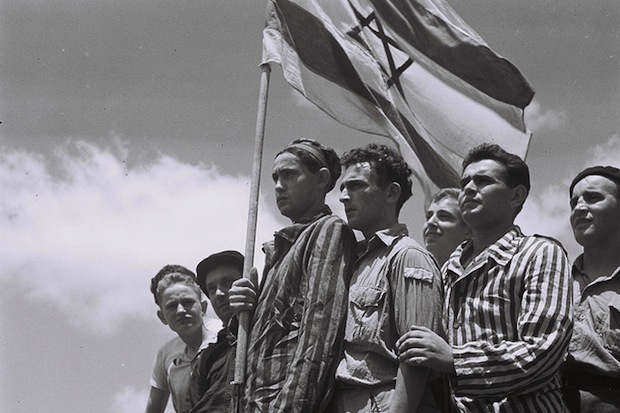The Israeli Holocaust discourse illustrates the — still — conflicted position of Mizrahi Jews in Israeli society. Perhaps we could design a Mizrahi identity that draws from the roots of its own unique history and not from that which is imposed upon it externally.
By Batya Shimony
A year ago on Holocaust Memorial Day I was driving in my car to Be’er Sheva and listening, as I usually do, to Galei Zahal – the army radio station. It suddenly dawned on me just how much the broadcast schedule had changed compared to previous years. All the familiar stories of that day – the testimonies of the atrocities of the Holocaust – were being told from new angles. The blend of programs was almost balanced, the agenda being to present a variety of groups within Israeli society: the story of women in the Warsaw Ghetto Uprising, the story of the children, the story of the Libyan and Tunisian Jews and even a discussion of the Holocaust as viewed by the Arab sector. Without a doubt, this trend is the result of| the fiery identity discourse that’s been taking place in Israel’s social and cultural spheres in recent years, which has been particularly intense regarding the role the Holocaust plays in forming the Israeli identity in general, and that of Mizrahi Jews in particular.
The issue of the connection Mizrahi Jews have to the Holocaust is nothing short of a deep complex that calls for comprehensive research. In her study of the topic, Hanna Yablonka sought to describe the historical narrative that excluded Mizrahi Jews from the Holocaust discourse, as well as the attempt that has been made, since the 1980s, to bring them closer to the Israeli mainstream by way of a uniting memory of the Holocaust. In the final chapter, entitled “Branding the Memory,” she marks the celebrations of the 60th anniversary of the end of World War II as a peak indicating the social integration of Mizrahi Jews into the Israeli experience. Yablonka argues that the Mizrahi representatives sent by the State of Israel to various ceremonies around the world (politicians Silvan Shalom and Moshe Katsav) and what they said in these ceremonies, serve as proof that the memory branded into the Israeli DNA had succeeded in creating a unified identity, as envisioned by Zionism. However, the picture emerging from the literary and cultural discourse is quite different from this historical interpretation, which is mainly focused on reaffirming the notion of “the melting pot.”
The unification process described by Yablonka occurred in tandem with a diametrically opposed process of differentiation involving alternative definitions of community identities that dismantle the unifying Zionist discourse and alter the identity map within Israeli society. This process is well expressed in Israeli literature. Since the 1990s books have gradually emerged, written by second-generation Mizrahi writers laying claim to the memory of the Holocaust and incorporating it in their work. Handling it as if it were their own, they manipulate and mold it with grotesque instruments, presenting the wrongs this memory has facilitated for all to see.
The dialogue Mizrahi writers have with the Holocaust is diverse. Some writers are heavily ridden with “Holocaust envy,” desperately wanting to participate, wishing they too had survivors in their family. One such writer is Yossi Avni-Levy, whose work is obsessed with the Holocaust. However, this seemingly naïve obsession bares its aggressive claws in descriptions that reveal a dual stance. Thus for example, the protagonist in A Man Without Shadow (2007) recalls how his schoolteacher had asked all the children in class to share their family’s story in the Holocaust. To his great horror, the boy realizes that “…out of his swarm of uncles and aunts, not one of them… had been in the Holocaust” (88), but for one distant aunt who somehow ended up in Crimea, where she was brutally murdered by the Nazis along with her entire family. Here was the redeeming aunt, and the boy tells the story to his classmates with so much emotion, that it causes his teary-eyed schoolteacher to see him “in a whole new light” (90).
But after telling his aunt’s long story in great detail, the narrator confesses that there never was an aunt Batsheva and that he had concocted the entire horrifying story in his feverish mind, after having listened to his classmates’ Holocaust stories and being gripped with envy:
“… [A]nd he so wanted to be one of them! So wanted to have grandfathers and grandmothers who had died, according to Jewish custom, in Treblinka!”
This short tale illustrates the intense emotional conflict Mizrahi Jews experience in relation to the role the Holocaust plays in the Israeli experience. Living in Israel as a Mizrahi means growing up in a society that sanctifies the memory of the Holocaust and turns it into symbolic capital that is passed on from father to son. At the same time, it means belonging to an excluded group that is devoid of status, whose history and chronicles are of no interest except to the extent that they pertain to a colorful folklore or affirm the Zionist rescue narrative.
His sense of not being seen leads Avni’s protagonist to adopt the Holocaust story and make it his own. The storytelling style is childish and naïve, yet not all that innocent (as the author was a grown man remembering his childhood). It sheds light on the distortion of values involved in adopting this narrative, as the protagonist wishes he could trade his “swarm of uncles and aunts” for one survivor who had known much suffering, just to gain the approval of his old Ashkenazi teacher. He prefers the (Ashkenazi) “Jewish custom” of dying, over the Mizrahi custom of gluttonous eating and drinking (according to the Orientalist tradition on which the Israeli identity discourse is based).
As opposed to this stance of conflicted identification, in recent years it has become possible to identify a unique awakening among Mizrahi writers who have a biographical connection with the Holocaust. Lea Aini in Rose of Lebanon (2009) and Yossi Sucary in Benghazi-Bergen-Belsen (2013) claim their own family and community’s part in the established historical memory of the Holocaust. In both cases the survivors’ experience of the Holocaust had not been acknowledged by the establishment, and despite having undergone such terrible suffering they received no recognition whatsoever from the Israeli public and memorial institutions.
Aini describes her father, an Auschwitz survivor: “[h]e sits there on the eve of the Holocaust Memorial Day, scrunched under his robe, already perched across from the TV that repeatedly broadcasts the appropriate programs and films, which offer no mention of the Jews of Greece – thus, Father continued sacrificing himself, and us, on the altar of Survival, as if none of it had ever ended” (228). The terrible rage that built up inside him was violently directed at his family members.
Rage is where Sucary’s novel begins, telling the story of a group of Libyan Jews that were sent to the Bergen-Belsen concentration camp. The many reviews written about the novel highlighted the historical importance of the issue that had finally been brought into public awareness. However, Sucary was not only seeking to present the common fate shared by Libyan and European Jews. His main aim was to show the hatred of Jews directed at their own brethren, and how the European Jews themselves abused the Libyan Jews. The last part of the novel describes the horrors of the concentration camp through the eyes of Silvana, the central protagonist.
![Prisoners standing during a roll call. Each wears a striped hat and uniform bearing colored, triangular badges and identification numbers. *”Buchenwald, [Thuringia] Germany, 1938-1941. [http://www.ushmm.org/ United States Holocaust Memorial Museum] Prisoners standing during a roll call. Each wears a striped hat and uniform bearing colored, triangular badges and identification numbers. *''Buchenwald, [Thuringia] Germany, 1938-1941. [http://www.ushmm.org/ United States Holocaust Memorial Museum]](https://static.972mag.com/dev/uploads//2013/03/prisoners.jpg)
The descriptions of the brutality shown towards Silvana by the European Jews seem far more extreme than those of the Germans. When dealing with the Germans, Silvana is resourceful and manages to find solutions, while in her encounters with the Ashkenazi Jews she is humiliated in the most extreme and vulgar way. As she’s being raped, a thought crosses her mind: “who could save her? Her own white Jewish brethren, who treated her as though she were a human animal that weaseled her way into their group?” (299).
These descriptions illustrate the novel’s underlying agenda, which is not merely to depict the experience of the Libyan Jews in the Holocaust, but also, and perhaps mainly, to protest against the condescending and hurtful attitude the Ashkenazi Jews had towards them. This was the same attitude the Libyan Jews were shown later on, upon their arrival in Israel.
***
As I stated at the start of this article, it seems that in recent years a special effort has been made to allow everyone to express themselves on Holocaust Memorial Day. This process of political correctness still covers the cracks and wounds of the Mizrahi identity. The most disturbing aspect of it is that it still feels like when it comes to the Holocaust and Mizrahi Jews, this is the gateway Mizrahis have to go through in order to emerge “whiter” on the other side. The process is becoming increasingly industrialized, with one of its mainstays being the organized journeys of Israeli high school students to Poland. In this context, Itamar Toby Taharlev shares how he and his Mizrahi friends considered it their duty to totally connect to the experience of the Diaspora and the Holocaust on their journey to Poland, while his Ashkenazi friends took the trip as nothing more than an opportunity to let loose and enjoy the freedom of being away from their parents. His concluding remarks are sobering: “[t]hat journey to Poland might in fact have been a journey for manufacturing an Ashkenazi identity.”

At the other end of the spectrum, Roy Lachmanovich (Hebrew), a third generation Holocaust survivor, beseeches us to include Mizrahi Jews in the memory of the Holocaust, as the generation that had firsthand experience of the Holocaust is gradually dying out. He warns that “if Israeli society doesn’t wake up in time we will find ourselves battling against the receding centrality of this holy day.” Both columns were written in 2012 and express the same position – Mizrahi Jews still occupy the social margins of Israeli society, and the Holocaust is still the target. However, while Taharlev’s position is critical, Lachmanovich’s is instrumental: we need Mizrahi Jews to remember the Holocaust, just like they were needed in the early days of the state to settle the empty territories so these wouldn’t be claimed by the Arabs.
These contradicting viewpoints were going through my mind as I was watching the documentary film “The Hangman” (2011), which tells the story of Shalom Nagar, the Yemenite Jew who was Adolf Eichmann’s executioner. The movie was highly acclaimed and was even said to be a milestone in Holocaust documentaries, after which Holocaust films would no longer be the same. The film kept me in suspense, but I couldn’t get past the editing, which aimed to present the paradoxical tension between brutality and compassion which the filmmakers believe is representative of Israeli society. They did it well, with a sequence of contradicting visual images that create a sense of anxiety and uneasiness. Close-ups of slaughtering shots, and then Nagar’s naïve character sharpening his knife in preparation for the slaughter, with dramatic music on the soundtrack. One moment you see a gentle goat about to be slaughtered, bleating softly, and the next you see its carcass hung on a hook as its being skinned. The tension reaches its peak when Nagar describes Eichmann’s hanging and taking his body off the rope, which in Nagar’s own words “spewed” out trapped air and blood on him, and he felt as though he had been cursed. But something about the film made me uneasy.
There is something manipulative and elusive about the film. It’s not really about the Holocaust or Eichmann’s hanging, nor is it truly interested in Nagar’s character. These are all recruited in support of an all-Israeli narrative that presents the dark forces bubbling beneath the seemingly innocent façade. The film makes good use of a Forrest Gump-like structure, which serves its agenda well. “Forrest Gump,” as we all may recall, follows the life of a mentally challenged individual who witnessed – and in some cases was actually involved in – some of the defining events in American history. Yet due to his disability he relays these events without truly understanding their significance. This type of description defamiliarizes the events on one hand, but at the same time it enables an examination of the place of “the other” within society, a place that is simultaneously on the inside and the outside of society.

Similarly, Nagar finds himself involved in fateful events, almost by chance, and reports them with casual naivety, almost as if he were not aware of their significance. Thus, for example, we learn that he was among those who contributed to the establishment of Kiryat Arba, the Jewish neighborhood in Hebron, in the 1970s, and that he was even invited, with great honor, to live there. He also closely witnessed the massacre of Muslim worshipers committed by Baruch Goldstein at the Cave of the Patriarchs. Despite the difficult experiences he has been exposed to, Nagar maintains a humane worldview that is full of innocence and grace.
What is disturbing is the instrumental use of Nagar’s character, or if you will the Mizrahi character – first in the historical sense. Nagar as it turns out, had refused to take on the role of hangman and so a lottery was held and he was chosen for the job. This raises an interesting issue: for as long as the trial was being held the Israel Prison Service made sure Eichmann stayed alive. They had Mizrahi Jews guarding him so he wouldn’t be assassinated. Nagar even checked Eichmann’s food to make sure it wasn’t poisoned. When Nagar asked his commanding officer about it, the officer replied: “listen, one Yemenite is not a problem… many Yemenites have kicked the bucket… but Eichmann – that’s a problem, because this trial is going out to the whole world.” Yet after Eichmann was sentenced to death, why was it so important to give the honor to the Yemenite guard who had been the closest to Eichmann for the past six months, the one who accompanied him to the toilet and watched him defecate? Nagar’s refusal should have been enough, especially when there were many others who were ready to volunteer for the job. But they held a lottery. Was a lottery really held? Nagar was not present to witness it and received the order from his commander. The experience left him traumatized, and he could only find partial relief by turning to religion.
The film also uses Nagar as an instrument. The filmmakers chose to present him in a one-dimensional way, thus resurrecting the stereotypical image of the Yemenite. Blau writes: “Shalom Nagar is a heartwarming character. An old Yemenite man, optimistic and god-fearing, with a great sense of humor, who seems to stand in perfect stereotypical contrast to any Holocaust film” (Hebrew). It’s fascinating to see how with one stroke of the pen Blau dismantles one stereotype only to preserve and reaffirm another.
But the stereotype of the Yemenite cracks as soon as one chips the sugary veneer and discovers the real person. In an interview he gave to Chen Kotas-Bar, Nagar offers a much sharper view than the one presented in the film: “I know that if an Ashkenazi had hanged Eichmann, they would have shown him much greater respect,” he says. “I’m Yemenite. They didn’t even invite me to the Holocaust museum, to Yad Vashem, to explain, to talk about it. No one. Nothing. Why should a Yemenite come to the Holocaust museum? I see it on TV. People come, go, they show it all the time. Each one tells his Holocaust story. I was there. I did it. Of all people the one who actually did the deed, the one who hung him! No one comes to invite him, nothing! What, I need to go and ask? If they don’t want me, that’s fine. Leave me alone. I don’t need that kind of rubbish. If someone doesn’t want me, I don’t want them. So I won’t go, and I won’t tell any of it” (Hebrew).
***
Anger and protest are important stages in the processes of recognizing one’s own identity. This can also be seen in feminist criticism of women’s writing. At the turn of the millennium this outburst of rage found expression in the form of several literary texts written by second-generation Mizrahi writers. Their unique treatment of the Holocaust and the Mizrahi identity was the first expression of protest against their erasure and exclusion from the Israeli social and cultural realm.
The filmmakers silenced Nagar’s rage, that same rage that should have led to an awakening of consciousness. Nagar plays into their hands as the naïve Yemenite, the one on whose back Israeli history is edited while he gets pushed to its margins.
The Israeli Holocaust discourse illustrates the (still) conflicted position of Mizrahi Jews in Israeli society. Literature presents the grotesque attempt to infiltrate the core of the Israeli essence by using the memory of the Holocaust, and the protest of those who were there and who had to struggle for their memories to be recognized. Once we clean out the literary stables, perhaps we should go back and examine the processes involved in defining Mizrahi history and consciousness, and perhaps we could do the following: design a Mizrahi, or possibly ethnic identity, that draws from the roots of its own unique history and not from that which is imposed upon it externally.
Batya Shimony is a senior lecturer in the department of Hebrew literature at Ben-Gurion University of the Negev and Achva Academic College. Her research interest is Mizrahi literature in its various aspects: identity, Holocaust, gender and immigration.
This article was first published in Hebrew on Haokets.



